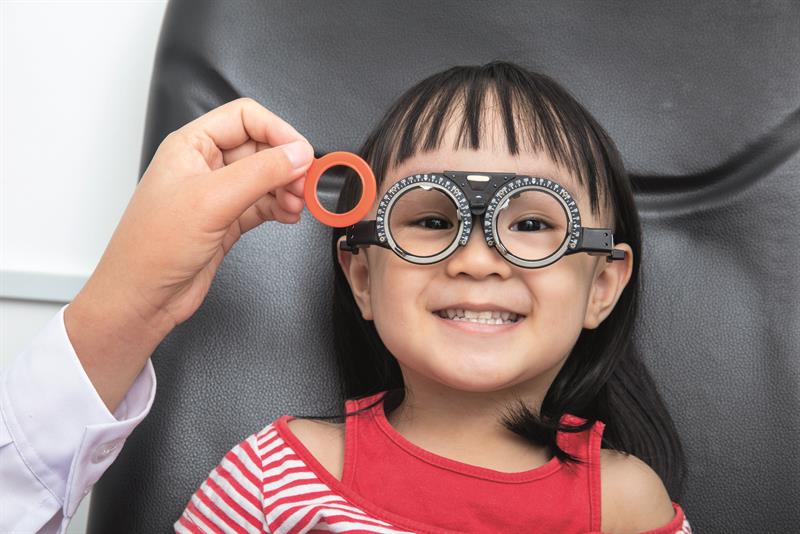
1: Welcoming children to the practice
Walk through your practice’s front door, get down on your knees and have a look around. Is there anything that you can see that would be welcoming to a young child entering for the first time? A child’s eye view of a reception desk with someone looming behind it can be quite scary. If you really want children to feel at home have (suitably disinfected) children’s activities clearly visible and accessible and invite them, either directly or via their accompanying adult to investigate that area as soon as possible. When talking to the child try and get down to eye level with them, maintain plenty of personal space and try and avoid sudden movements. Building trust is critical.
2: Maintaining the interest of younger patients
For most children, attention span is inversely related to their age, with younger children struggling the most to maintain attention. Keep their attention by maintaining a conversation with them and getting them to answer questions constantly. Rather than just saying ‘look at that light or letter’ turn it into a challenge. Ask them if they can see the item you want them to fixate on and then tell you if it changes at all. Maybe switch the light off and on a couple of times to make it into a game. Use expressions like ‘I bet you can’t tell me what that letter is,’ rather than ‘please read the letter on a certain line.’ Give positive affirmations every time they do as you ask and make them, rather than any adult they may be with, the centre of your attention.
3: Talking to teens
Treat teenagers like adults. Don’t try to be ‘cool’. Your job is to carry out the eye exam that they probably don’t want in a confident, competent and professional manner. Avoid closed questions at all costs. Ask about behaviours that will give clues about any vision problems that they might have. Observing where they are holding their phone while they are waiting to see you (which they inevitably will be doing) will give indications. Are they narrowing their eyes to read for example? If you are going to ask about what their hobbies or cultural influences are then make sure that you show genuine interest in their response. Ask what they know about any condition that you diagnose them with. Find out what their ‘accepted beliefs’ are, ask if they know anyone who has the condition, how do they get along with it? Above all be empathetic.

4: Educating about eye health
Always try to unmask any fears or misinformation that a child might have before explaining what is going on. Find out where they got their information from and start your education from the facts rather than discrediting the source. Expressions like ‘I can understand why you might think that but...’ are useful. Have a variety of different education tools available to you. Children, like adults, learn in different ways so access to model eyes, paper and multi-coloured pencils, and diagrams are helpful as are computer generated animations. Have reference sources available for the child, and parent, to look up following the appointment. Be realistic about whatever the consequences of any intervention you may be recommending are. Don’t set up false hopes or impressions that are unlikely to materialise, for example, by wearing the prescribed glasses their eyes won’t get any worse, unless that is evidentially the case. Avoid over emotive language unless there is an immediate risk to sight or life that needs an urgent response. Affirm understanding by asking the child, and/or parent, to repeat back any critical points that you have made and record that this has happened.
5: Ensuring contact lens success
Find out what the child and parent’s understanding of contact lenses are before you start any fitting. Make sure that you correct any misunderstandings or false expectations. It is very important that the parent is fully engaged with the whole process and that this is recorded. Whenever you examine the eye, do so with a clear explanation of what you are about to do, especially if it involves touching the patient. It’s never a bad idea to apply a contact lens to your own eye before placing one on the patients to reduce anxiety. It’s also a good idea to allow a child to handle a lens, especially a soft one, ahead of the wearing experience to get a sense of what it feels like. Explain exactly how you are going to apply the lens and where you want the child to be looking at each stage. Never tell the child that they ‘won’t feel a thing’, or that the lens ‘won’t hurt’. Explain that they will feel something on the eye at first, but that the awareness should disappear quickly. Always make sure sufficient time is allowed for lens care instruction and that both child and parent know what to do should any problems arise. Get the child to see themselves in contact lens as soon as possible and reinforce the benefits.

6: Product choice and styling
Have your children’s frames at a height and in a setting that is suitable for a child to access easily. Have mirrors appropriately positioned so they are able to see themselves wearing their frames. Align the frame selection that you have with appropriate point of sale support material from your suppliers. Provide as wide a choice of designs and materials as you possibly can. Your children’s frame selection area should be an integral part of your dispensing area, not seen as an add on. Try to set a budget range for all your child frames that is relatively narrow and obtain agreement with the parent or payor that all the frames a child will try on are within a budget that they are happy with. Avoid likenesses of frames with celebrities unless this is something that the child brings up as a wish. Positively reinforce the child’s appearance with all frames to try to build confidence in them having to wear spectacles. Repeat back positive phrases the child uses to describe themselves in the chosen frames.
7: Frame fitting and collection
Make the child the star of the appointment. Present the spectacles to them as if they were a new toy and be enthusiastic about
the benefits of wearing them. Ask if the child wants to put them on themselves or let you do it. Make sure that either way there is an immediate benefit of wearing the correction to be seen, for example get a myope to look out of a window when first trying on the correction. Reinforce the vision benefit first. Once this is established let the child know that you are going to adjust the glasses specially just for them. Make this an important element of the collection and, as with all interactions, explain exactly what you are doing before you do it and get the child’s ‘permission to proceed’. Once fitted properly let the child see themselves. Don’t ask a closed question about whether they like the glasses or not, try and get them to describe how much better they can see in them.
- Ian Davies is an optometrist now working as an independent motivational speaker, coach and business consultant.
